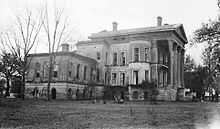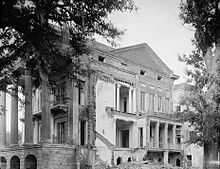Belle Grove Plantation (Iberville Parish, Louisiana)
| Belle Grove | |
|---|---|
|
Front (River facade) of Belle Grove in 1938 | |
| Location | White Castle, Louisiana vicinity |
| Coordinates | 30°10′37″N 91°09′14″W / 30.177°N 91.154°WCoordinates: 30°10′37″N 91°09′14″W / 30.177°N 91.154°W |
| Built | 1852–1857[1] |
| Demolished | 1952 |
| Architectural style(s) | Greek Revival and Italianate |
| Governing body | Private |
Belle Grove, also known as Belle Grove Plantation, was a plantation and elaborate Greek Revival and Italianate-style plantation mansion near White Castle in Iberville Parish, Louisiana. Completed in 1857, it was one of the largest mansions ever built in the South, surpassing that of the neighboring Nottoway. Nottoway is often cited as the largest antebellum plantation house remaining in the South.[1][2] The masonry structure stood 62 feet (19 m) high and measured 122 feet (37 m) wide by 119 feet (36 m) deep, with seventy-five rooms (including a jail cell) spread over four floors.[1]
History
Belle Grove was owned by John Andrews, a wealthy sugar planter originally from Virginia.[3] Andrews owned over 7,000 acres (2,800 ha) spread over several plantations, with Belle Grove having 3⁄4 mile (1.2 km) of river frontage. He founded Belle Grove during the 1830s, with Dr. John Phillip Read Stone as a partner. Andrews assumed full ownership in 1844, when the partnership was dissolved. By the 1850s, his more than 150 slaves were producing over half a million pounds of sugar each year.[1]
Andrews built the mansion from 1852 to 1857 at a cost of $80,000, not including the free (slave) labor or the plentiful cypress lumber and hand-made bricks produced on the plantation. The house was designed by New Orleans architect Henry Howard.[1][4] Andrews had a legendary rivalry with the owner of Nottoway Plantation, John Randolph. This competition even extended to their mansions, with both massive structures designed by Howard in a mix of the Greek Revival and Italianate styles.[1]

Following the American Civil War and ensuing collapse of the plantation economy, Andrews sold the home and plantation in 1867 to James Ware, for the meager sum of $50,000.[1] The Ware family continued to live and farm the plantation until the early 1920s. After several bad crop years, they were forced to sell the home. From 1925 onwards the house sat vacant.[1]
The post-War era at Belle Grove saw the finely crafted home rot away in Louisiana's harsh environment. Neglect allowed a leaky roof to expand and destroy one wing of the mansion. Several owners purchased the home, each with aspirations of restoration, but none had the means necessary in the lean years of the Great Depression and World War II to stop the onslaught of rapid decay. On March 17, 1952, a mysterious fire during the night destroyed what remained of the house.[2]

Dozens of books have been written regarding Belle Grove's beauty and charm, while hundreds of photographs have been published illustrating those narratives.[2] During the late 1930s a comprehensive set of photographs and architectural drawings were produced for the Historic American Buildings Survey. This material, an inventory of the house's contents made on the death of James A. Ware in 1908, and a drawing of the missing wing, are all available on the website of the Library of Congress.
Famous photographer Clarence John Laughlin described Belle Grove in his work, Ghosts Along the Mississippi:
When completed, its tremendous mass rose on huge brick foundation arches over twelve feet above the surrounding earth, its walls and mantels were plastered and carved by the most expert European craftsmen money could secure, its great flight of brick steps was covered with imported marble, its door knobs and keyhole guards were of silver, its pillars bore Corinthian capitals six feet high but of the utmost refinement. Its theatrical magnificence would have delighted the Bibiena family - seventeenth century designers of the most elaborate and grandiose stage sets for kings. Yet it was not heavy, or pompous. It managed somehow, to combine vastness with delicacy; titanic proportions with grace and warmth....[2]
See also
- Belle Grove (Terrebonne Parish, Louisiana), on Bayou Black
References
- ↑ 1.0 1.1 1.2 1.3 1.4 1.5 1.6 1.7 Matrana, Marc R. (2009). Lost Plantations of the South. Jackson, MS: University Press of Mississippi. pp. 184–192. ISBN 978-1-57806-942-2.
- ↑ 2.0 2.1 2.2 2.3 Friends of Belle Grove Plantation of Louisiana Website
- ↑ Federal Writers' Project (1947). Louisiana: A Guide to the State. p. 549. ISBN 978-1-60354-017-9.
- ↑ Sternberg, Mary Ann (2001). Along the River Road: Past and Present on Louisiana's Historic Byway. LSU Press. p. 256. ISBN 978-0-8071-2731-5.
External links
 Media related to Belle Grove Plantation (Iberville Parish, Louisiana) at Wikimedia Commons
Media related to Belle Grove Plantation (Iberville Parish, Louisiana) at Wikimedia Commons- Historic American Buildings Survey (HABS) No. LA-36, "Belle Grove, White Castle, Iberville Parish, LA", 21 photos, 36 measured drawings, 23 data pages, supplemental material
- Friends of Belle Grove Plantation of Louisiana Website
- Belle Grove Plantation Records, University of North Carolina at Chapel Hill
